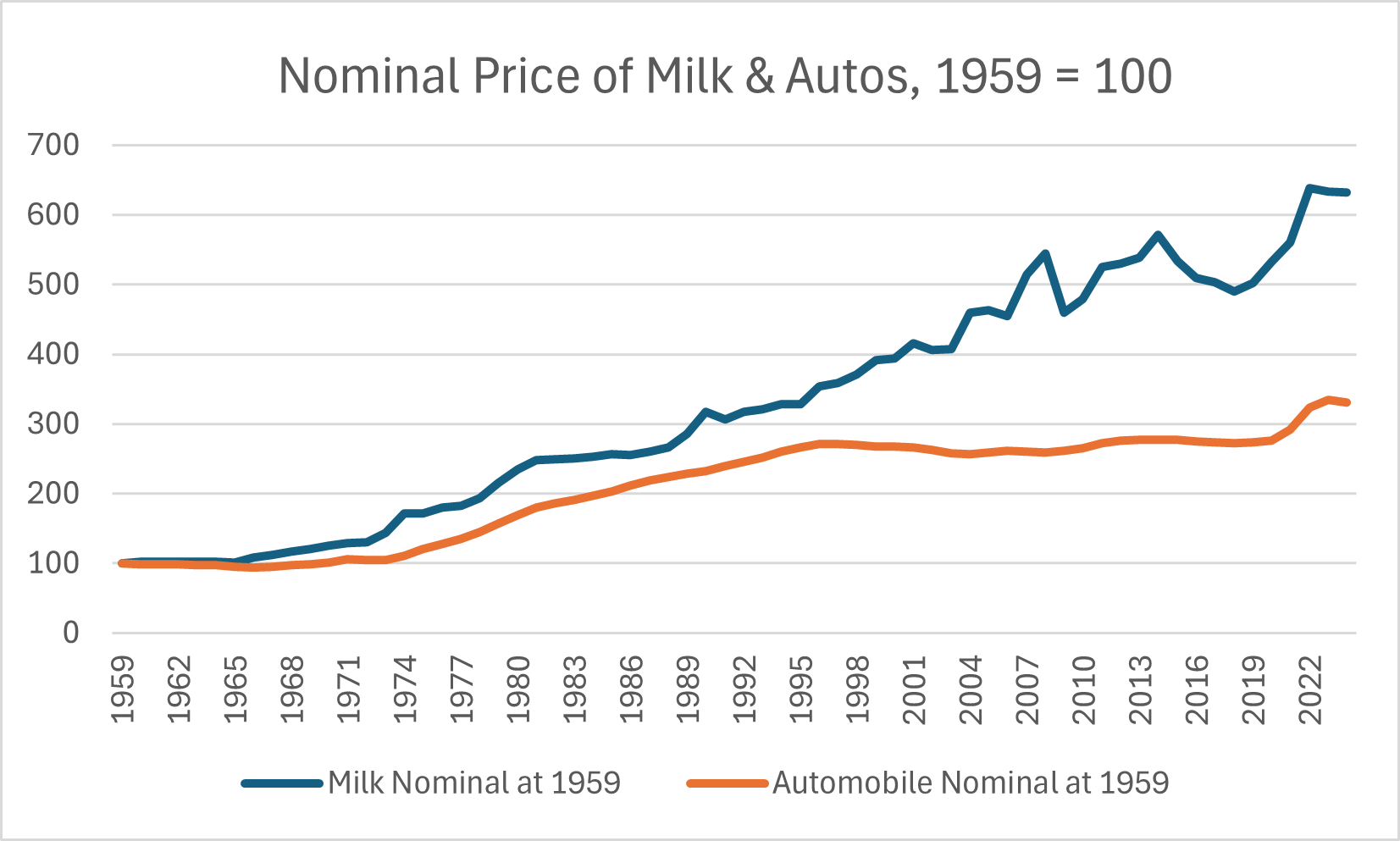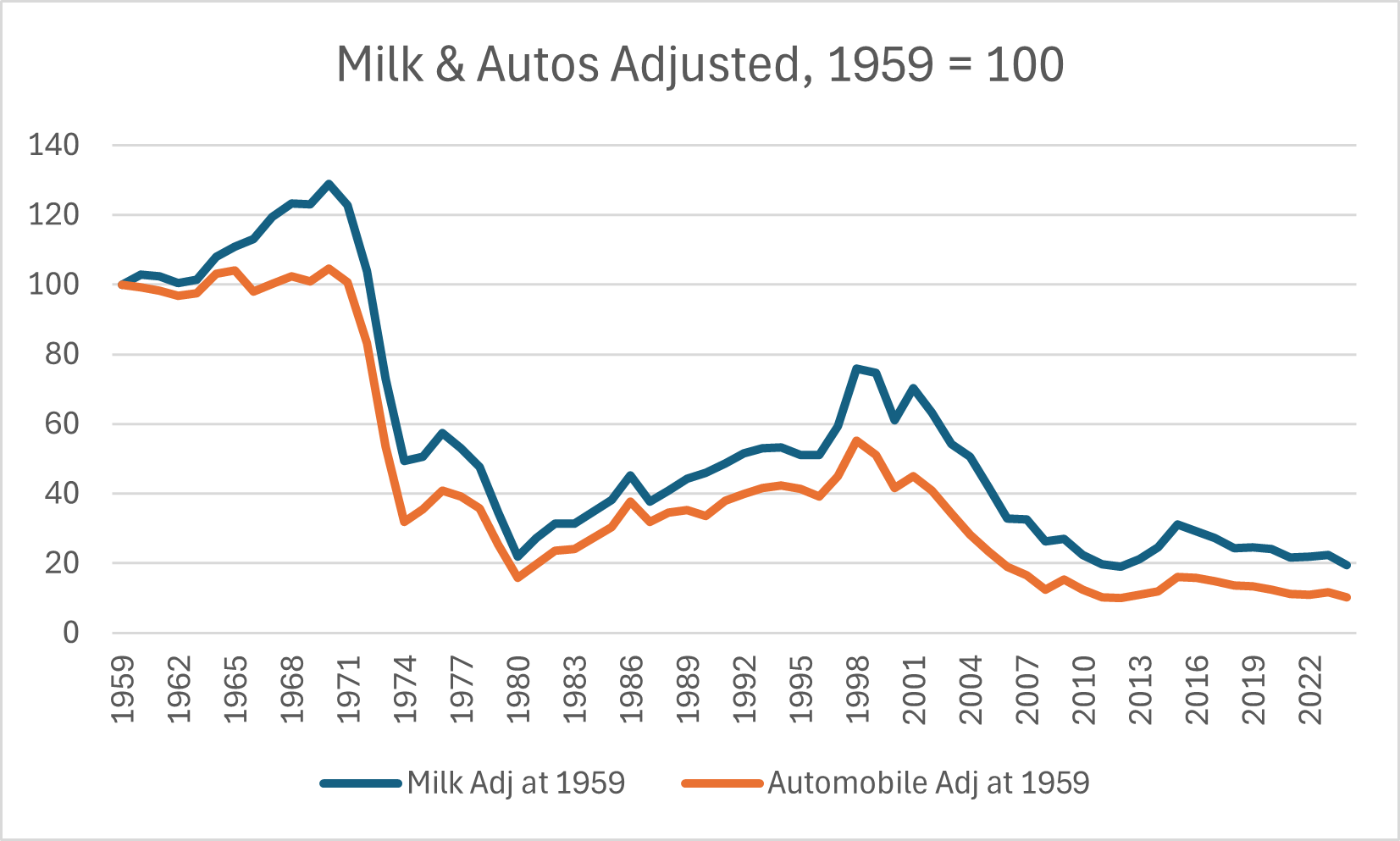Debasement of the United States Dollar, Part III
Harvest Moon, 06 October 2025
This is the final post of a three-moon theme – the debasement of the United States dollar (USD). Herein I discuss the price of two common commodities in the United States, milk and automobiles, adjusting for the debasement of the USD.
In my 2025 sturgeon moon post, I adjusted the value of the USD over time with respect to an equally weighted basket of three commodities: wheat, oil, and gold. Using this basket as a reference, I concluded that, after 1971, when untethered from gold, the USD debased at an average of 96.33% each year, corresponding to an inflation rate of 3.81%.
In last moon’s post, I discovered, that, despite the increased nominal cost of housing (house ownership and rental), the real cost of housing in the United States, adjusted for the debased USD, has decreased over the decades.
This moon, I analyze whether two commodities, a gallon of milk and a new automobile, have become more (or less) expensive in real terms.
For data about the price of automobiles, I turned to:
For data about the price of fresh, whole milk, I turned to:
This website expresses the cost of commodities in terms of yearly inflation, so I reconstituted the prices of milk and automobiles from these rates.
First, let us look at the standardized nominal prices of these two commodities, where their prices are set to 100 in the year 1959.
Figure 1

We are naturally interested in the inflection point at 1971, but the years preceding the untethering of the USD from gold are also of interest. The nominal price of milk was steady from 1959 to 1965. The span from 1966 to 1971, however, had a nominal increase of 19%. The nominal price of an automobile, however, dropped 6.5% from 1959 to 1966. Like milk, it increased afterwards through to 1971, 13% from 1966 to 1971.
We see nominal prices rise steadily after 1971. From 1972 to 2024, milk’s price increased 384%, while an automobile’s price increased 215%. The average annualized rates of price increase for the two commodities are thus 3.0% and 2.2% respectively.
Adjusting these prices by annual USD debasement paints a completely different picture. Figure 2 shows such adjusted prices, where the prices of milk and automobiles are scaled to 100 in the year 1959.
Figure 2

Several trends are evident in the figure above. The first two trends are what we discussed above: milk prices increased during the 1960s, while automobile prices remained stable. We also see that, after 1971, the adjusted prices of milk and automobiles are remarkably synchronized. Their adjusted prices rise and fall together. And finally, we see a broad reflection of United States economic conditions: inflation during the 1970s, economic growth during the 1980s and 1990s, falling prices after the tech bubble crash, and stable prices since the 2008 banking crisis.
The adjusted prices of milk and automobiles dropped dramatically during the past 50 years. Adjusted for USD debasement, milk in 2024 cost only 19% of what it cost in 1972. An automobile in 2024 cost only 12% of what it cost in 1972. In annualized rates, milk’s price decreased an average of 3.3% during this period, while that for automobiles was 4.2%.
The decrease in adjusted prices seems so counterintuitive. Further research, however, validates our conclusions. The USDA states that the restructuring of the diary industry toward fewer, larger farms has reduced costs:
The reasons for relatively less expensive automobiles are more efficient technologies, more efficient processes, and lower labor costs due to manufacturing in developing countries:
So we come to the same conclusion as the previous moon. The nominal costs of commodities in USD have increased drastically over the past 50 years. But when we adjust for the debasement of the USD, said prices have decreased.
|
Previous Post |
Next Post |
